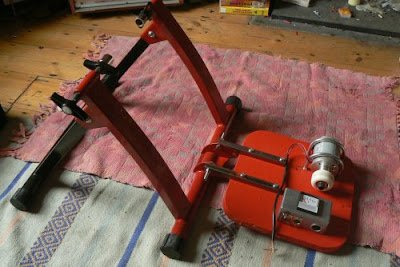
I've just done a festival, gigs every lunchtime and evening for three full days. Mainly acoustic acts, but with one full band at the end of every night (Rachel Gittus Band, Seize the Day (9 of them now - had to add an extra battery powered mixer (Behringer UBB1002 - a nice flexible mixer, up to 5 mic inputs, 4 stereos, fx & mon loops - actually enough on it's own for a lot of gigs) and Magicfolk, who were suitably impressed with the new electric guitar amp, which proved to be more than up to the job.
I was running up to four generators, working across a battery into the sound system load. The battery has suffered greatly from neglect (was stored where I couldn't get to it and charge it for nine months) and is probably heavily sulphated and high impedance; it's showing 13.2 volts after not being in use for a couple of days, so most power was going straight to the amps, drawing as much as it needed from the bikes. When the bikes were going we generally breaking even, with surplus current going into the battery.
I've yet to document the new connection panel, but it basically has lots of input & output sockets (all now 4 pin XLRs) and a switch connection to the battery, with a circuit breaker (25A) and a 30-0-30A ammeter (from a scrapped old car) in series. No live voltmeter as yet, which will be more useful if I choose to run the system with the battery switched out (which should work fine, although I didn't get a chance to play over the weekend).
Note the lighting in the pic above (showing the lovely Rachel Gittus band). I used one of my 16W shaded flourescent lights on a marquee pole, and two LED spots (bought as a sound to light set of three for £15, I spotted they came with a remote 14v DC PSU, and gave them a go) to give the red & blue highlights. I also added blue LED fairy lights (each set run on 2 AA batteries for weeks) on some mic stands - they were bought in Wilkinsons, I think, last Christmas - a bit of forward thinking on my part. My camera was in a high senstivity mode (ISO800, perhaps) but there was enough for some decent pics, some a lot sharper than this one.
I should add a little about the power cabling - now everything is on 4 pin XLRs, outlets on sockets, inputs on plugs, I was able to be fairly flexible in connecting bikes & systems. For the bass amp, I wired in an extra small battery on a short cable to the bass amp to provide a local reserve to avoid volt drop being significant as the current increased on load which would happen otherwiswe. As I've tried to wire everything with both genders of connectors to give a pass-through, I was able to wire in the bike on the other side of the stage (rider just visible far right of the pic) though this too. This of course did involve using one cable in 'reverse', but since I'd put both genders on the generators too, this was fine - as long as gnd stays on pin 1 and +ve on pin 4, it's all fine, and almost acts as a ring main, current flowing to where it's needed. Connecting the batteries in parallel with varying states of charge wasn't ideal, but I did check the ammeter and very little current was flowing to equalise it... so yes, a successful revision of arrangements there, I think.







